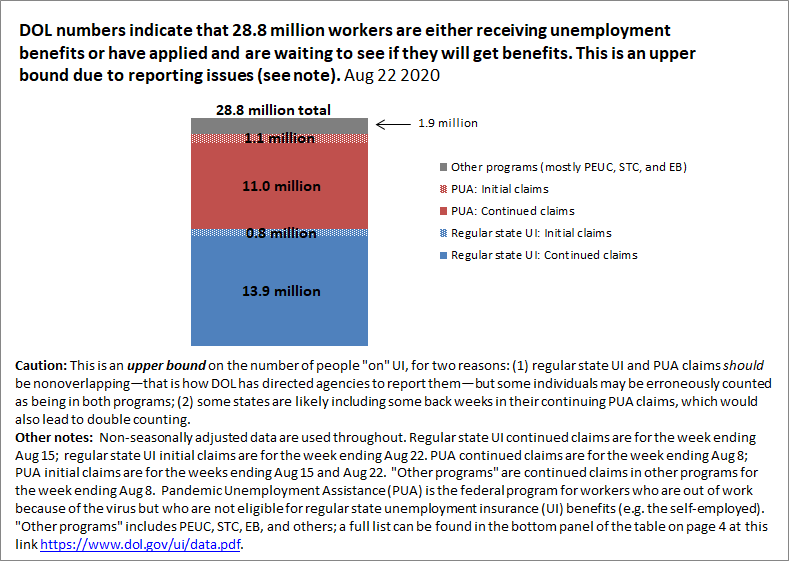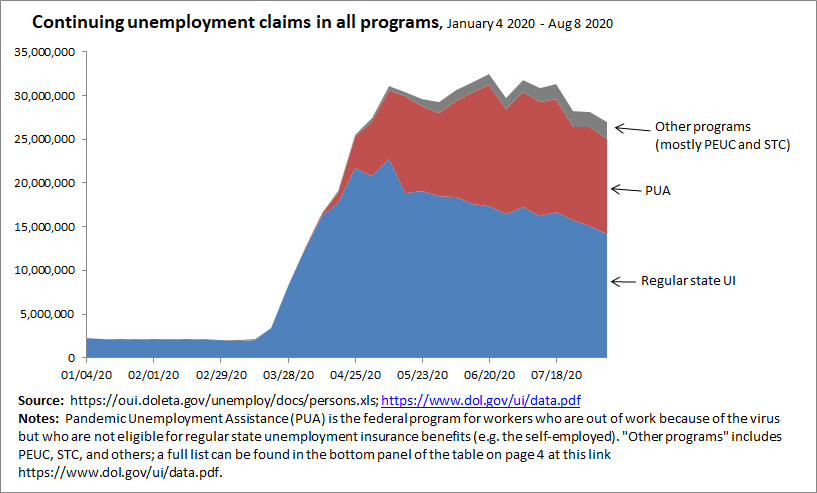WILL THIS EVER CHANGE. Last week, 1.4 million workers applied for unemployment insurance (UI). Breaking that down: 822,000 applied for regular state UI (not seasonally adjusted), and 608,000 applied for Pandemic Unemployment Assistance (PUA). 1/ https://www.dol.gov/ui/data.pdf ">https://www.dol.gov/ui/data.p...
Some are saying there were “just” 1.0 mil UI claims last week. That’s wrong. It ignores PUA, the federal program that is serving millions of workers who are not eligible for regular UI, like gig workers. It also uses seasonally adjusted data, which is problematic right now. 2/
Some good news for data nerds in this release—starting next week, DOL is fixing the way they do seasonal adjustments! 3/
Republicans in the Senate allowed the across-the-board $600 increase in weekly UI benefits to expire. Last week was the fourth week of unemployment in this pandemic for which recipients did not get the extra $600. 4/
That means people on UI are now are forced to get by on around 40% of their pre-virus earnings. It goes without saying that most folks can’t exist on 40% of prior earnings without experiencing a sharp drop in living standards and enormous pain. 5/
Earlier this month, Trump issued a sham of an exec memorandum. It& #39;s supposed to give recipients an extra $300 in benefits (typically), but in reality even this drastically reduced benefit is delayed, is only available for a few weeks, and is not available at all for many. 6/
These pieces have some really good details on that executive memorandum, if you’re interested. 7/ https://www.nytimes.com/article/stimulus-unemployment-payment-benefit.html">https://www.nytimes.com/article/s... https://tcf.org/content/commentary/trumps-lost-wage-assistance-program-no-substitute-federal-unemployment-benefits/?agreed=1">https://tcf.org/content/c...
Basically, the President’s executive memorandum is a false promise that truly does more harm than good because it diverts attention from the desperate need for the real relief that can only come through legislation. 8/
This is cruel, and terrible economics. The $600 was supporting a huge amount of spending by people who now have to make drastic cuts. The spending made possible by the $600 was supporting 5.1 million jobs. Cutting that $600 means cutting those jobs. 9/
The map in Figure B of this blog post shows many jobs will be lost by state over the next year now that the $600 unemployment benefit has been allowed to expire. 10/ https://www.epi.org/blog/cutting-off-the-600-boost-to-unemployment-benefits-would-be-both-cruel-and-bad-economics-new-personal-income-data-show-just-how-steep-the-coming-fiscal-cliff-will-be/">https://www.epi.org/blog/cutt...
We remain 12.9 million jobs below where we were before the virus hit, and the unemployment rate is higher than it ever was during the Great Recession. Now is not the time to cut benefits that support jobs. 11/
This is the 23rd straight week initial claims are far greater than the worst week of the Great Recession (GR). If you restrict to regular state claims (b/c we didn’t have PUA in the GR), this is the 23rd straight week claims are greater than the 3rd-worst week of the GR. 12/
Initial claims (including both regular state benefits and PUA) have risen the last two weeks. This is not the directionality we want to be seeing here, folks. 13/
Though initial claims have risen the last 2 weeks, they& #39;re below where they were when the $600 expired. Some have wondered if that drop is due to the $600 expiring. NO. Claims remain historically high, but they& #39;ve been pretty steadily dropping since the peak in early April. 14/
The $600 was not the reason people were applying for unemployment insurance. In fact, rigorous empirical studies show that any theoretical work disincentive effect of the $600 was so minor that it *could not even be detected.* 15/
For example, a study by Yale economists found no evidence that recipients of more generous benefits were less likely to return to work. 16/ https://news.yale.edu/2020/07/27/yale-study-finds-expanded-jobless-benefits-did-not-reduce-employment">https://news.yale.edu/2020/07/2...
Case in point: in May/June/July —with the $600 in place—9.3 MILLION people went back to work. A large share of those were making more on UI than they had made at their prior job, but it did not keep them from going back. 17/
Further, there are 11.2 million more unemployed workers than job openings, meaning millions will remain jobless no matter what they do. Cutting the $600 cannot incentivize people to get jobs that are not there. 18/ https://files.epi.org/charts/img/196746-25298.png">https://files.epi.org/charts/im...
Even further, many people simply can’t go to work right now because it’s not safe for them or their family, or because they have care responsibilities as a result of the virus. Cutting the $600 cannot incentivize them to get a job, it’s just causing pain. 19/
Cutting the $600 is also exacerbating racial inequality. Due to the impact of historic & current systemic racism, Black and Brown communities are suffering more from this pandemic, and have less wealth to fall back on. They are being hurt worse by the expiration of the $600. 20/
This is particularly true for Black and Brown women and their families, because in this recession, these women have seen the largest job losses of all. 21/
DOL numbers suggest that right now, 28.8 million workers are either on unemployment benefits, have been approved and are waiting for benefits, or have applied recently and are waiting to get approved. 21/
HOWEVER, the above chart is an *upper bound* on the number of people “on” UI, for 2 reasons. First, regular state UI & PUA claims should be nonoverlapping—that is how DOL has directed agencies to report them—but some folks may be erroneously counted as being in both programs. 22/
And, some states are likely including some back weeks in their continuing PUA claims, which would also lead to double counting. For more info, see the discussion around Figure 3 in this paper. 23/ https://www.federalreserve.gov/econres/feds/files/2020055pap.pdf">https://www.federalreserve.gov/econres/f...

 Read on Twitter
Read on Twitter



